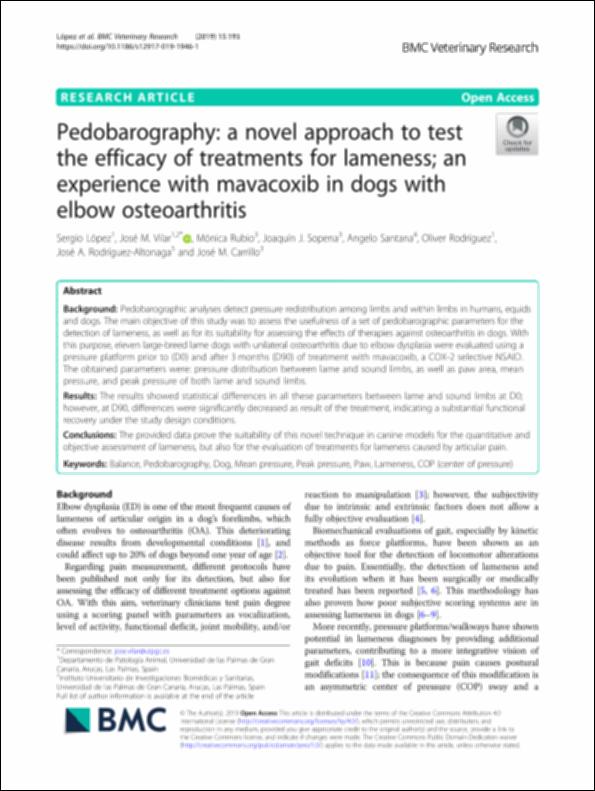Por favor, use este identificador para citar o enlazar este ítem:
http://hdl.handle.net/10637/10766Pedobarography : a novel approach to test the efficacy of treatments for lameness : an experience with mavacoxib in dogs with elbow osteoarthritis
| Título : | Pedobarography : a novel approach to test the efficacy of treatments for lameness : an experience with mavacoxib in dogs with elbow osteoarthritis |
| Autor : | López Barbeta, Sergio Vilar, José M. Rubio Zaragoza, Mónica. Sopena Juncosa, Joaquín Jesús. Santana, Angelo Rodríguez Lozano, David Oliverio Rodríguez-Altonaga Martínez, José Antonio Carrillo Poveda, José María. |
| Materias: | Pressure.; Cojera en los perros - Diagnóstico.; Osteoarthritis in dogs.; Presión.; Perros - Locomoción.; Dogs - Locomotion.; Lameness in dogs - Diagnosis.; Animal mechanics.; Mecánica animal.; Miembros anteriores - Heridas y lesiones - Diagnóstico.; Animal locomotion.; Locomoción animal.; Miembros posteriores - Heridas y lesiones - Diagnóstico.; Arm - Wounds and injuries - Diagnosis.; Leg - Wounds and injuries - Diagnosis.; Osteoartritis en los perros. |
| Editorial : | BioMed Central. |
| Citación : | López, S., Vilar, JM., Rubio, M., Sopena, JJ., Santana, A., Rodríguez, O. et al. (2019). Pedobarography : a novel approach to test the efficacy of treatments for lameness : an experience with mavacoxib in dogs with elbow osteoarthritis. BMC Veterinary Research, vol. 15 (11 jun.), art. 193. DOI: https://doi.org/10.1186/s12917-019-1946-1 |
| Resumen : | Background: Pedobarographic analyses detect pressure redistribution among limbs and within limbs in humans, equids and dogs. The main objective of this study was to assess the usefulness of a set of pedobarographic parameters for the detection of lameness, as well as for its suitability for assessing the effects of therapies against osteoarthritis in dogs. With this purpose, eleven large-breed lame dogs with unilateral osteoarthritis due to elbow dysplasia were evaluated using a pressure platform prior to (D0) and after 3 months (D90) of treatment with mavacoxib, a COX-2 selective NSAID. The obtained parameters were: pressure distribution between lame and sound limbs, as well as paw area, mean pressure, and peak pressure of both lame and sound limbs. Results: The results showed statistical differences in all these parameters between lame and sound limbs at D0; however, at D90, differences were significantly decreased as result of the treatment, indicating a substantial functional recovery under the study design conditions. Conclusions: The provided data prove the suitability of this novel technique in canine models for the quantitative and objective assessment of lameness, but also for the evaluation of treatments for lameness caused by articular pain. |
| Descripción : | Este artículo se encuentra disponible en la página web de la revista en la siguiente URL: https://bmcvetres.biomedcentral.com/articles/10.1186/s12917-019-1946-1 |
| URI : | http://hdl.handle.net/10637/10766 |
| Derechos: | http://creativecommons.org/licenses/by/4.0/deed.es |
| ISSN : | 1746-6148 (Electrónico) |
| Fecha de publicación : | 11-jun-2019 |
| Centro : | Universidad Cardenal Herrera-CEU |
| Aparece en las colecciones: | Dpto. Medicina y Cirugía Animal |
Los ítems de DSpace están protegidos por copyright, con todos los derechos reservados, a menos que se indique lo contrario.


